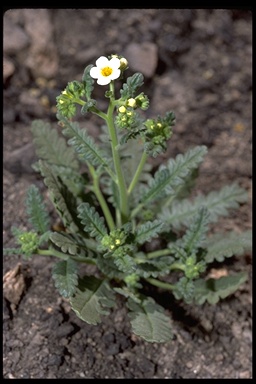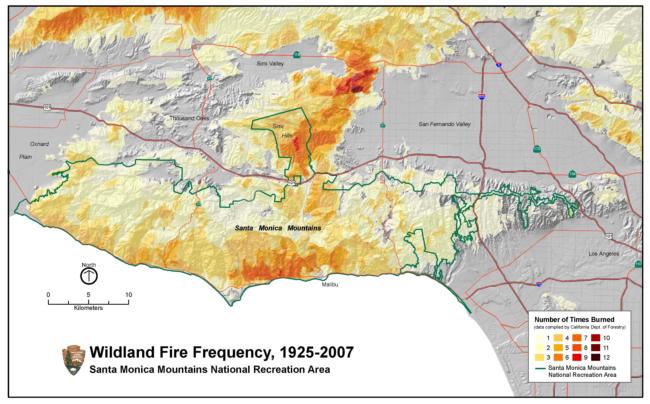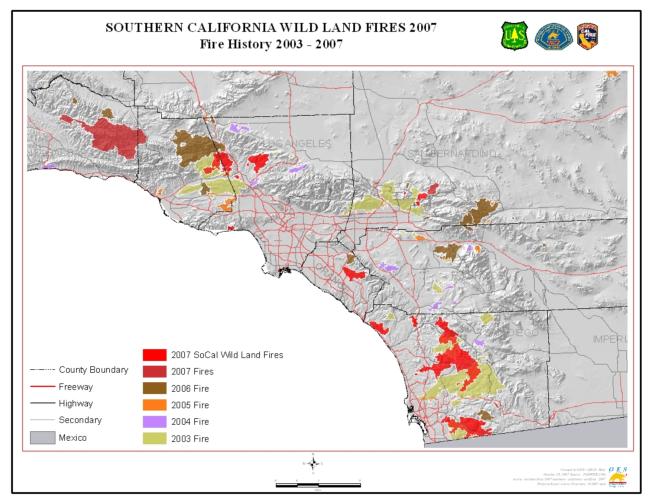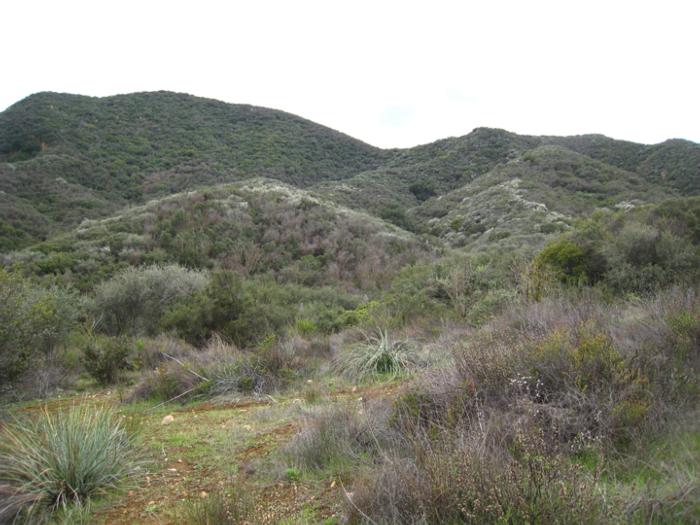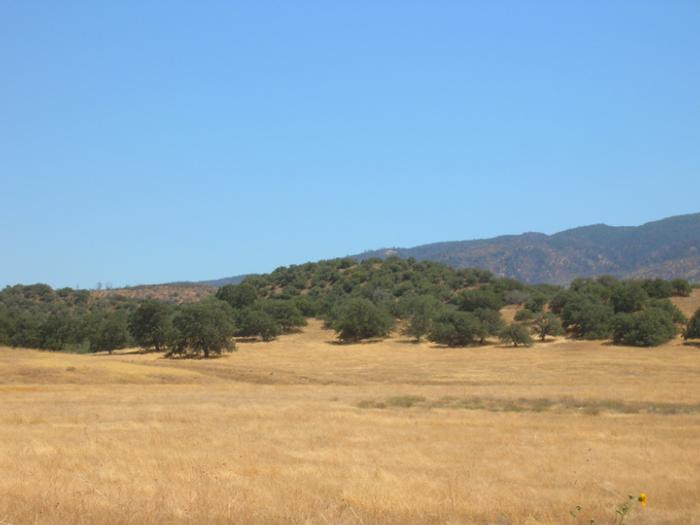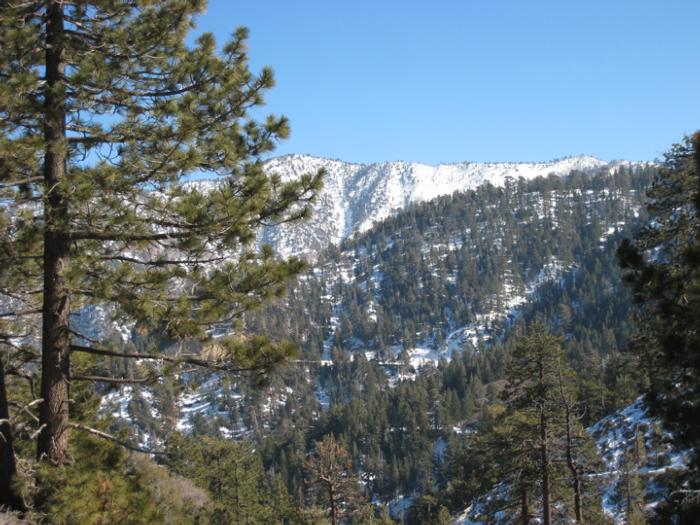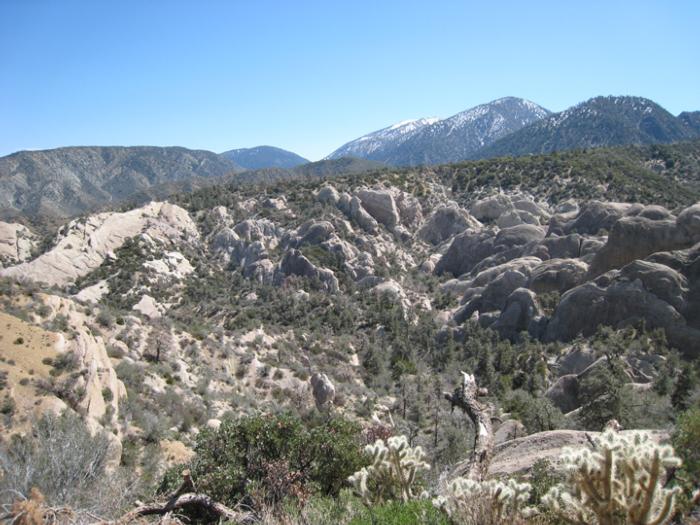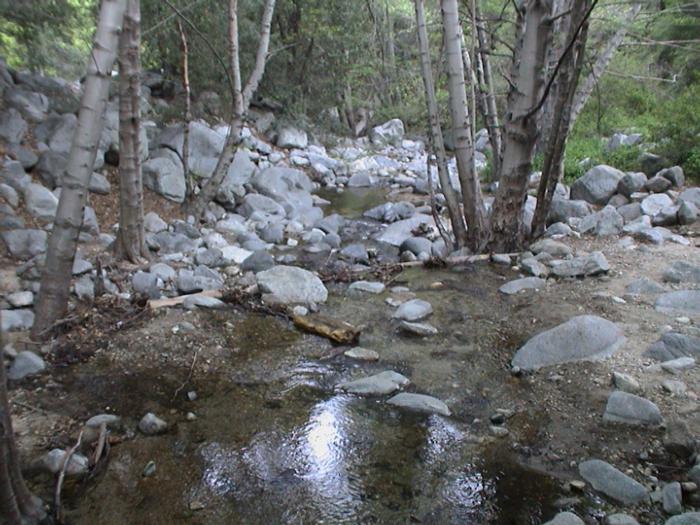Mediterranean climates and plant adaptations
The climate type in much of California is described as Mediterranean climate, with winter rains and dry, hot summers. Mediterranean climates are found in only five places in the world: California (extending into southern Oregon and northern Baja California, Mexico); the Mediterranean region itself; and the subtropical south or west coasts of Chile, South Africa, and Australia. All of these areas support uniquely adapted groups of plants and animals, and most of these places are prone to large wildfires.
The plant communities found in these areas are dominated by large, woody, evergreen shrublands. Individual plants have small thick waxy leaves to help retain moisture through the dry summers and have developed adaptations to their native fire regimes. Some shrubs have underground root crowns that allow them to re-sprout after a fire. Others are killed by fire, but produce seeds that can remain in the ground for many years, germinating in response to smoke, heat, and ash. Some species do both. During the first spring following a fire, it is common to see “fire followers”: annuals that germinate in response to a fire and produce beautiful flowers. They won’t be seen again until the next fire.
Fire-follower Phacelia brachyloba from Los Padres National Forest, Gerald and Buff Corsi, Cal Academy of Sciences
Fire regimes
Mediterranean habitat types are often described as “fire adapted”, but it is important to realize that they are adapted to specific fire regimes. Elements of a fire regime include the spatial, or place-related, relationship between plants and fire, the intensity and severity of a fire, and the temporal, or timing–related, relationships between vegetation and fire: when, and how often, does fire naturally occur?
The spatial aspect of fire regime has to do with where within the vegetation fire occurs – not just from a bird’s-eye view, but also in cross section. Fire can occur at three levels. Ground fires occur along and within soils that are rich in organic matter. Surface fires spread through vegetation along the ground surface; this takes place with most grass fires. Crown fires occur at the tops of trees and shrubs – regardless of whether the top is 70ft off the ground in a forest fire, or 10-15 feet off the ground in a shrub=dominated plant community. Crown fires have longer flame lengths and spread more rapidly than ground and surface fires. Any particular wildfire incident can combine each of these types of burns.
Intensity is a technical term describing the amount of energy being released (as heat and light) in a fire, and the way fuel is consumed per acre and per minute. Severity is a measure of the damage caused by a fire, and is usually described in terms of the amount of plant mortality and soil alteration.
The temporal aspects of the fire regime of a particular place and plant community include which season fires occur in, and how long the fire season is. In Southern California fires naturally occur during summer and fall, when dry weather removes most of the moisture from many plants and hot dry winds can spread any fires that ignite. In unaltered systems, it also includes when natural sources of ignition, such as lightning, occur. In Southern California, however, most fires are ignited by human activity, and the largest fires occur in the summer during years of low rainfall and extended dry periods and in the fall during Santa Ana wind events. Fire frequency describes how often fires occur, and “return interval” is used to describe the average number of years between large fires.
Southern California shrubland habitats are resilient to specific fire frequencies. More frequent fires and unnaturally short fire return intervals can result in the replacement of native communities. This process is known as type conversion. In many areas, fires are occurring more frequently than they would naturally, often leading to type conversion from native habitat to a vegetation community dominated by invasive weeds.
Southern California Habitats
While the descriptions below discuss the major terrestrial vegetation communities in Southern California, there are additional vegetation types. These habitats may overlap in many places .
Chaparral
Chaparral is California’s most extensive native plant community. It is also one of the State’s most characteristic wilderness types, dominating foothills and mountain slopes from the Rogue River Valley in southern Oregon to the San Pedro Martir in Baja California. Properly defined, chaparral is a kind of shrub-dominated community of hard-leaved plants shaped by summer drought, mild, wet winters, and fires that naturally occur every 30 to 150 years plus – more frequent fires can lead to habitat loss and conversion to non-native grasslands. Dominant woody shrubs in the chaparral include chamise, manzanita, ceanothus, scrub oak, and laurel sumac. Softer plants such as buckwheat and sage, as well as yuccas, can also be found here. Chaparral often grows in a continuous stand of dense vegetation, creating a potentially flammable landscape. Some chaparral shrubs have flammable characteristics such as small fine leaves, lots of litter, and peeling bark. Fires in chaparral are usually high intensity and spread rapidly through the system. Wind driven, chaparral-fueled fires often burn hot and produce tall flames and copious embers.
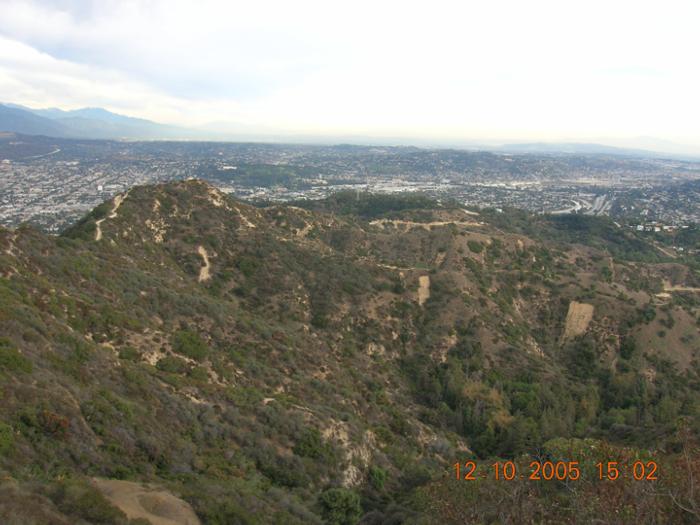
Sage scrub
Sage scrub, sometimes called “soft chaparral”, is composed of drought deciduous, soft-leaved fragrant shrubs such as California sagebrush, buckwheat, and a variety of sage species. Sage scrub may also contain some woodier plants such as laurel sumac and lemonadeberry, yuccas (Our Lord’s Candle), and in some areas, cacti including prickly-pear and cholla. It’s found in the coastal valleys, plains, and sandy interior foothills below 2500 ft elevation. Sage scrub is generally shorter and more open than chaparral. This is the most common habitat type in the coastal areas of Southern California. Due to various human impacts from farming and ranching to urban and suburban development the extent of this plant community has been reduced to less than 15% of the area it covered prior to European settlement. Sage scrub burns easily and frequently, though too-frequent fires often result in conversion to non-native weedy annual grasses.
Oak woodlands and savannahs
In Southern California, oak woodlands are usually dominated by the evergreen coast live oak, though deciduous valley oaks can be found in northern parts of the region, and Engelmann oaks in the south. Open savannahs with individual or clumps of trees can be found in broad valleys and rolling hills, while dense canopies can be found along stream corridors. Other species commonly found in these communities include toyon, hollyleaf cherry, hollyleaf red-berrry, Mexican elderberry and softer perennials like poison oak. In a few areas, California walnut may be a dominant tree. Oaks have large spreading canopies which are mirrored underground by wide root zones. The shade of oaks can inhibit the growth of more flammable species, and keep the area near your home cool and moist. Oaks are not highly flammable and often recover well after a fire, re-sprouting in branch forks or at the base. While maintaining defensible space may require trimming individual branches, it rarely requires removal of an entire oak tree. Many counties and cities in the region have ordinances limiting oak pruning and removal so be sure to check with your local fire agency before trimming or removing oaks.
Montane forest
Montane forests are generally pine and fir dominated communities that occur at higher elevations in southern California’s mountain areas from 3000 up to 8500 ft. At the lower parts of the range, dominant trees include big-cone Douglas fir and Coulter pine as well as canyon live oak and California bay. On higher slopes, lodgepole, limber, ponderosa, Jeffrey, and sugar pines occur along with white fir, incense cedar, western juniper, and black and canyon oaks. The low elevation species are sensitive to fire, and thus only found on rocky areas where the geology itself is fire-resistant. In recent years, drought combined with beetle and disease infestations have increased the number of dead trees, and thereby the fire risk in montane forests in this region. Most of the montane forest in southern California occurs in National Forests and a few isolated high elevation communities like Wrightwood, Big Bear, Idyllwild, and Julian. Residents in these areas should contact CalFire and their local forestry and fire experts and refer to the
UC Forest Stewardship site.
Desert montane
Arid slopes of the inland portions of southern California’s mountains support pinyon-juniper woodlands, dry chaparral, sagebrush, and desert scrub communities. These vegetation types occur in open canopy stands with sparse undergrowth. Because of the natural separation of the vegetation, these communities do not carry fire well, and have long fire return intervals. In recent years, however, non-native annual grasses have invaded these communities – creating a continuous dry fuel load. Hence, the frequency of fire in these desert areas has drastically increased. In the year after a fire, these disturbance adapted grasses may be the first plants to germinate, competing with the native vegetation, and slowly converting the natural habitat to more flammable grasslands.
Riparian Forest
Riparian forests are the willows, sycamores, cottonwoods, alders, coast live oaks, and other trees and plants that occur along streams in southern California. Depending on the steepness of the topography, riparian forests can occur in narrow canyons or along broad, wooded corridors. Historically, these wet areas acted as fire breaks during wildfires. The greatest impacts occurred after a fire, when flows of sediment down the stream from eroding slopes could wipe out banks, then establish new ones. In recent years, however, many of our riparian forests have been invaded by exotic species. Two of these, Arundo (also known as giant cane) and Tamarisk (also known as salt cedar), grow in dense stands. In summer when water levels recede they may dry out and become dormant turning into potential fuel for fires. This can change these natural fire breaks into flaming corridors, rapidly fueling the spread of a fire. Giant reed and salt cedar both recover very quickly after a fire, much faster than the native trees, and expand their range along the river or creek.
Fire and Climate Change in Southern California
Global warming has occurred rapidly over the past half-century. In the arid U.S. Southwest, this will mean that future droughts will likely be more severe, and it will mean a change in the timing and type of precipitation. In California, less precipitation will occur as snow, meaning that less water can be stored in the snow-pack, and that dry summers could see even less water availability. Summertime peak temperatures will increase in many places. Fire “seasons” may become even longer.
Rundel, Philip W. and Robert Gustafson 2005. Introduction to the Plant Life of Southern California. University of California Press, Berkeley. 316 pp.
Stephenson, John R., and Gena M. Calcarone. 1999. Southern California Mountains and Foothills Assessment: Habitat and Species Conservation Issues. General Technical Report GTR-PSW-172, Pacific Southwest Research Station, Forest Service, USDA. 402 pp.
